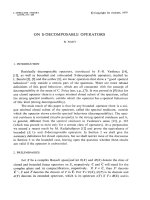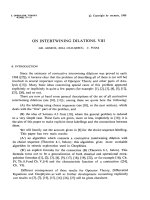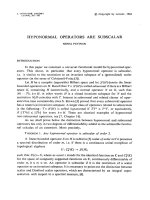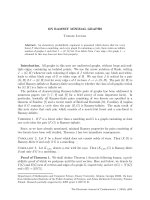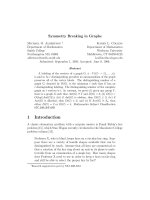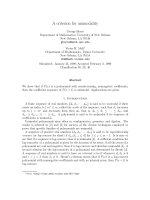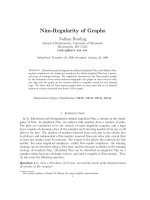Báo cáo toán học: "Online Coloring Known Graphs" docx
Bạn đang xem bản rút gọn của tài liệu. Xem và tải ngay bản đầy đủ của tài liệu tại đây (114.95 KB, 9 trang )
Online Coloring Known Graphs
Magn´us M. Halld´orsson
Science Institute – University of Iceland
IS-107 Reykjavik, Iceland
, www.hi.is/
∼
mmh.
Submitted: September 13, 1999; Accepted: February 24, 2000.
Subject Classification: 05C15, 68W25.
Keywords: graph coloring, online algorithms.
Abstract
The problem of online coloring an unknown graph is known to be hard.
Here we consider the problem of online coloring in the relaxed situation where
the input must be isomorphic to a given known graph. All that foils a compu-
tationally powerful player is that it is not known to which sections of the graph
the vertices to be colored belong. We show that the performance ratio of any
online coloring algorithm with advance knowledge of the input graph is at least
Ω(N/ log
2
N), where N is the number of vertices. This matches and generalizes
the bound for the case of an unknown input graph. We also show that any
online independent set algorithm has a performance ratio at least N/8.
1 Online Graph Coloring
Graph coloring is the problem of assigning the fewest possible colors to the vertices
of a graph so that adjacent vertices receive different colors. In the online version,
the input graph is given only one vertex at a time, along with the edges to previous
vertices, and the algorithm must irrevocably color the given vertex before receiving
later ones.
The Known-Graph Online Model Online problems receive much of their dif-
ficulty from the fact that the input is hidden. Clearly, if the whole input sequence
was given, the problem reduces to the offline version. But, what if the input was
known, but not the sequence in which it was given? In the case of graphs, suppose
1
the electronic journal of combinatorics 7 (2000), #R7 2
the input had to induce a graph isomorphic to a graph known in advance, but the
identification of the presented vertices was not given. Can we then color the graph
relatively easily?
Formally, consider the following game for two players, Alice and Bob.
1. Alice presents Bob with a graph G on N vertices.
2. For i =1, ,n
a) Alice presents a vertex v
i
with all edges from v
i
to v
1
, ,v
i−1
. The graph
induced by vertices v
1
, ,v
i
is isomorphic to a subgraph of G.
b) Bob responds with a color c(v
i
) that is distinct from the color of any vertex
v
j
adjacent to v
i
, j<i.
In ordinary parlance, Bob an algorithm, while Alice is the adversary. Time com-
plexity, however, is not the main concern in the online scenario, and since the total
number of possible game sequences is bounded by 2
poly(N)
, we may as well consider
Bob to be as Alice’s equal.
The input graph G is referred to as the underlying graph, while the subgraph that
is incrementally given to the algorithm is the presented graph. The former has N
vertices, while the latter contains n vertices.
The value of the game is the number of colors used by the algorithm (Bob) di-
vided by the chromatic number of G (the number of colors in an optimal offline
coloring). The worst-case game value, over all possible adversaries, is referred to as
the performance ratio,orthecompetitive ratio of the algorithm.
Results We show that the competitive ratio of any coloring algorithm, even with
full knowledge of the input graph G,isΩ(N/ log
2
N), where N is the number of
vertices of G. This generalizes the results of [6] for the known graph case. In fact,
for each N, we construct one particular graph that is hard to color that contains the
whole class of graphs given in [6] as induced subgraphs (each with about N/ log N
vertices).
The same lower bound holds also for randomized algorithm against an oblivious
adversary; in this version, Bob is allowed to base his color decisions on coin flips
which are hidden from Alice. It also holds for a further restricted model, where Alice
immediately commits a presented vertex to be a particular vertex in the underlying
graph as soon as Bob decides on his color. This implies that Alice is effectively
coloring the vertices online as well, and revealing those choices.
Related results Our results are an immediate generalization of those of Halld´orsson
and Szegedy [6] for the ordinary online coloring of an unknown graph. They con-
structed a class of log n-colorable graphs that require at least n/ log n colors online in
the worst case [6]. The best performance ratios known are O(n log log log n/ log log n)
by a deterministic algorithm [7], and O(n/ log n) by a randomized algorithm against
the electronic journal of combinatorics 7 (2000), #R7 3
an oblivious adversary [5]. Even for the case of trees, any online algorithm requires
log n colors in the worst case [3, 4]. In fact, the construction of Gy´arf´as and Lehel [4]
holds also for our model of a known input graph.
Bartal et al. [2] considered a different version of online coloring a known graph. In
their model, each presented vertex is identified on arrival with one of the underlying
vertices. The difficulty then lies in the fact that the algorithm does not know which
subset of the vertices will be presented. Also, the adversary is charged only for the
chromatic number of the presented subgraph, as opposed to that of the underlying
graph in our model. They prove a lower bound of Ω(n
1−log
4
3
) ≈ Ω(n
.2
) and an upper
bound of O(
√
n).
Online Independent Set We consider also the problem of finding an independent
set (or a set of mutually nonadjacent vertices) of maximum cardinality in the same
online model with a known graph. We relax the problem by allowing the algorithm
to color the vertices online and selecting at the end of the game the largest color class
as the independent set solution.
In spite of this relaxation, we can prove the worst possible bound of Ω(n) for the
performance ratio of any deterministic algorithm. However, if we allow the algorithm
randomization against an oblivious adversary, the best possible performance ratio is
θ(n/ log n).
2 Lower bound constructions for coloring
We shall focus on the following restriction to the game between Alice and Bob.
Note that only Alice’s moves are being restricted, while Bob is supplied with more
information. Hence, the lower bounds proved here immediately carry over to the
basic game of Section 1.
Let [k]={1, 2, 3, ,k} denote the set of colors used by the adversary, and [k]
t
denote the collection of all t-element subsets of [k].
1. Alice announces k, the number of colors she will use, x, a parameter, and n,the
number of vertices to be presented. She then presents a collection of subsets
C = {C
1
,C
2
, ,C
t
} of [k]
k/2
in some order.
1
This specifies an underlying graph
G on N = t · k/2 vertices and a coloring c : V (G) → [k] as follows. The graph
consists of t blocks of k/2 vertices each, with each block B
i
arranged in a clique
and colored with the colors in C
i
. Further, all vertices of B
i
are identically
adjacent to exactly those vertices in previous blocks whose colors are not in C
i
.
Formally, let C
i
= {c
i,1
, ,c
i,k/2
}. Then,
1
Note that the ordering of the blocks is not important, and in fact Alice could allow Bob to
choose the ordering. This implies that we implicitly give an exponential-size family of hard graphs.
the electronic journal of combinatorics 7 (2000), #R7 4
V (G)={v
i,
: i =1, ,t,=1, ,k/2},
c(v
i,
)=c
i,
,fori =1, ,t,=1, ,k/2,
E(G)={(v
i,
,v
j,q
):i<j and c
i,
∈ C
j
}∪{(v
i,
,v
j,q
):i = j}.
2. For i ← 1tot
Alice presents x (identically looking) vertices from block B
i
.
Bob colors these x vertices, consistent with his previous coloring.
Alice maps each of the x vertices to a different vertex of B
i
.
The oblivious adversary model modifies step 2 as follows:
Alice randomly picks subsets S
i
from each C
i
, such that |S
i
| = x.
for i ← 1tot
Bob gives colors to x (identical) vertices from B
i
.
The set S
i
is revealed to Bob.
Thus Alice makes all her decisions before Bob starts coloring. This is an oblivious
strategy, in that it does not depend on Bob’s moves; thus it is also necessarily a mixed
strategy, meaning that it uses randomization. Here, it is essential that Bob does not
have knowledge of S
j
, j>i, during round i. The above setup borrows many of the
ideas of [6].
It is clear from the edge description that the graph G is k-colorable. Further, since
at each round Alice selects a subset of the vertices of a block, the graph presented is
an induced subgraph of G. The number of presented vertices is n = t ·x = N ·2x/k.
The setup above is a restriction of the game described in section 1 in in several
ways. The most significant is that the mapping of the presented vertex to one in
the underlying graph, is indicated to Bob at the end of each round. This implicitly
informs Bob of the color that Alice used for the vertex. In [6], this was referred to
as a transparent model and shown that a matching O(n/ log
2
n) performance ratio is
achievable in this case. The global structure of the presented graph, including the
ordering of the blocks, is also given in advance. The only uncertainty is which x out
of k/2 block-vertices are being presented in each round.
We shall describe three strategies for Alice that force Bob to use many colors.
A strategy involves specifying the set collection C and a rule for mapping presented
vertices to particular vertices in the underlying graph. For the latter, we refer to
underlying vertices by their preassigned colors.
Terminology We say that Bob assigns vertices to bins while Alice colors.Thehue
of a bin is the set of colors among the vertices in the bin. We say that progress is
made on a vertex if the color assigned to that vertex increases the hue of the bin to
which the vertex was assigned.
The goal of the constructions is to make progress with each vertex, or at least
with a constant fraction of the vertices. Observe that if that goal is achieved, Bob
the electronic journal of combinatorics 7 (2000), #R7 5
is forced to use Ω(n/k) bins, since at most k/2 vertices in the same bin can make
progress. That yields a Ω(n/ log
2
n) approximation ratio. If x is additionally Ω(k),
the ratio is also Ω(N/ log
2
N).
Simple lower bound Let C =[k]
k/2
,andletx = 1. Namely, the set collection
consists of all subsets of size k/2. From each block, Alice presents a single vertex,
whose color she chooses so as to increase the hue of the bin used by Bob. We now
show that such a choice is always possible.
Lemma 1 Alice can make progress with every presented vertex.
Proof. Consider a vertex presented from block i,andletH be the hue of the bin
used. By the definition of the edges of the graph, H must be a subset of C
i
. Further,
H must also be a subset of the admissible colors for the last vertex added to the bin,
which is the set C
j
, for some j<i. Since the intersection of C
j
and C
i
contains at
most k −1 vertices, H is a proper subset of C
i
. Thus, there always exists an element
in C
i
− H, and Alice makes progress by assigning the vertex such a color.
We observe that the subgraph produced is precisely the lower bound construction
of [6]. A lower bound of Ω(N/ log
3
N) on the performance ratio of any deterministic
online coloring algorithm now follows.
This construction has the elegant property that the presented vertices appear in
the same order as they occur in the underlying graph. Thus, the presented vertices
form a subsequence of the ordered set of vertices of the underlying graph.
Optimal lower bound We want the set collection to have certain desirable prop-
erties. We call a collection dispersed if any pair of sets have at most 3k/8elementsin
common. Thus, we seek a binary code of length k with Hamming distance k/4. As
the following lemma shows, there exists a dispersed collection of exponential size.
Lemma 2 There is a dispersed collection of sets from [k]
k/2
with at least 1.1
k
ele-
ments.
Proof. Consider the following greedy algorithm. Pick any set S from [k]
k/2
and add
to collection. Eliminate from further consideration S and all sets that agree with S in
at least 3k/8 elements. Repeat until no sets remain. The number of sets that differ
from S in 2i elements equals the number of ways that i elements can be removed
from S, times the number of ways that i elements outside S can be added, or
k/2
i
2
.
Hence, the total number of sets eliminated from consideration in each round is at
most
k
2
k/2
k/8
2
, and the number of rounds is at least
k
k/2
k
2
k/2
k/8
2
≥ 1.1
k
.
the electronic journal of combinatorics 7 (2000), #R7 6
Alice chooses C to be a dispersed collection as above, and x to be k/8. In the
adaptive construction, the colors of the vertices are chosen so that she makes progress
on all of them (which we show possible below). In the oblivious construction, each
S
i
is chosen uniformly randomly among the subsets of C
i
of cardinality k/8.
Lemma 3 Each vertex is assigned to a bin with a hue of at most 3k/8 elements.
Proof. The vertices of a block B
i
must be assigned to different bins since they form
a clique. Let H be the hue of a bin to which a vertex is to be assigned. H must be a
subset of C
i
. H must also be a subset of the set of admissible colors the admissible
colors of the last vertex added to that bin, which corresponds to C
j
, for some j<i.
Since C is a dispersed collection, |H|≤|C
i
∩C
j
|≤3k/8.
Lemma 4 There is an adaptive strategy for Alice that makes progress on every ver-
tex.
Proof. Each vertex gets assigned to a bin whose hue contains at most 3k/8 elements,
in which case the remaining at least k/8 colors make progress. Thus, regardless of
how the other k/8−1 vertices of the block are colored, there is always a color available
for v that makes progress.
Lemma 5 There is an oblivious strategy for Alice that makes progress on at least
one fourth of the vertices.
Proof. All the k/2 colors of C
i
are equally likely to be assigned to a particular vertex
v of B
i
.Thereareatleastk/8outofk/2 colors that increase the hue of the bin
to which v is assigned. Thus, the probability of making progress with a particular
vertex is at least 1/4. By linearity of expectation, the expected number of vertices
making progress is thus at least n/4.
Lemmas 4 and 5 immediately lead to strong lower bounds on Bob’s performance.
Theorem 6 Ω(N/ log
2
N) is a lower bound on the performance ratio of any online
coloring algorithm, even when the input graph is given in advance. It holds also for
randomized algorithms against an oblivious adversary.
Proof. In the example constructed, N ≥
k
2
1.1
k
and n = N/2. The algorithm uses
at least expected (n/4)/(k/2) = n/k =Ω(N/k) colors, while the adversary uses k.
Since k = O(log N), the performance ratio is at Ω(N/ log
2
N).
Remark: The deterministic construction has the powerful property that every color
class of any coloring found by an online algorithm contains at most k/2=Ω(logn)
vertices. This implies e.g. that the lower bound holds also for the online version of
the Sum Coloring problem studied in [1], where the objective is to find a coloring
with the positive integers so that the sum of the values assigned to the vertices is
minimized. Also, note that Alice’s strategy is efficiently computable in time O(n)
per vertex.
the electronic journal of combinatorics 7 (2000), #R7 7
3 Online Independent Set Problem
We now consider the problem of finding a large independent set online, when the
original graph is given in advance. The algorithm (Bob) is allowed to form a coloring
of the vertices, and choose the largest color class at the end as the final solution.
Clearly, this allows for a considerable flexibility over requiring Bob to irrevocably
assign vertices to a single set. This version faithfully represent “onlineness” in that
the algorithm must irrevocably decide for every pair of nodes if they are to be in the
same independent set, and models somewhat more intelligent online strategies.
In this problem, the adversary is also evaluated in terms of the presented subgraph,
i.e. the independence number of the subgraph. However, we are interested in bounding
the performance ratio as a function of the size of the original graph. From the remark
at the end of the last section, it is clear that the Ω(N/ log
2
N) lower bound holds
also for the independent set problem. However, we can actually show the tightest
possible Ω(N) lower bound.
Adaptive construction The underlying graph contains N =2n vertices, a
i
,b
i
,
i =1, 2, ,n,withthea-vertices forming an independent set, b-vertices forming
a clique, and a
i
adjacent to b
j
iff i>j.Inasense,a
i
and b
i
form a block of
two identically looking vertices; the a vertices are good, belonging to the optimal
independent set, while the b vertices are bad, excluding any further addition of vertices
to the same bin.
Alice presents n vertices and, depending on the algorithm’s actions, maps the i-th
presented vertex either to a
i
or b
i
. Namely, if the vertex is placed in an empty bin,
then it will be declared to be a
i
; if placed in a nonempty bin, it will be b
i
.
Theorem 7 The performance ratio of any online independent set algorithm is at
least N/8, even if the graph on N vertices is given in advance.
Proof. If a vertex is placed in a nonempty bin, all remaining vertices will be adjacent
to it. Thus, by induction, bins accumulate at most two vertices. On the other hand,
at least half of the vertices will be a-vertices; hence, the size of the adversary’s solution
is at least n/2. The performance ratio is therefore at least n/4=N/8.
We can obtain a matching performance ratio using the ubiquitous First-Fit algo-
rithm that assigns each vertex in sequence to the first bin possible. Every bin, except
possibly the last one, must contain a node not in a particular optimal independent
set. If First-Fit outputs t nodes, it uses at least (n − 1)/t + 1 bins and the optimal
solution contains at most (t − 1)(n − 1)/t + 1 nodes. Thus, First-Fit’s performance
ratio is at most ((t −1)n +1)/t ≤ n/4+1/2.
the electronic journal of combinatorics 7 (2000), #R7 8
Oblivious construction For the oblivious case, we again use the same underlying
graph and present n = N/2 nodes. Here, we let the i-th presented node be good (i.e.
a
i
) with probability 1/2andbad (i.e. b
i
) with probability 1/2. With high probability
the sequence will contain n/2(1−o(1)) good nodes. For a particular bin to accumulate
nodes, all but possibly the last node must be good. The events of nodes being good
are independent. Thus, the probability that a given bin collects more than t nodes
is at most 2
−t
. Hence, the probability that all the (at most n) bins contain 2 log n
or fewer nodes, is at least 1 − n · 2
−2logn
=1− 1/n. Therefore, the expected size
of the largest independent set found is O(log n). Thus, the performance ratio of any
randomized algorithm is Ω(N/ log N), expected and with high probability.
A matching O(n/ log n) performance ratio can be obtained by a simple randomized
algorithm, even without knowledge of the input graph. We describe here an algorithm
for the case when the number of vertices n and the independence number α are known
in advance. The unknown case can be handled via a doubling technique, see [5].
Without loss of generality, α ≥ n/ log n.Letq =(1/2) log
n/α
n. Before coloring,
randomly partition the n vertices into n/q blocks, each of size q, ignoring the
remainder. Greedily color the vertices of each block independently. With probability
p = α/n, a random vertex is contained in the maximum independent set. Thus, with
probability at least p
q
=1/
√
n all the vertices of a given block form an independent
set. The probability that none of the blocks are independent is thus at most
1 −
1
√
n
n/q
≤ e
−
√
n/ log n
.
With high probability, some block is independent, and thus the expected size of
the independent set found is Ω(q). The performance ratio is then O(α/ log
n/α
n)=
O(n/ log n).
We summarize the above with the following theorem.
Theorem 8 The performance ratio of any randomized online independent set algo-
rithm against an oblivious adversary is at least Ω(N/ log N), even if the graph on N
vertices is given in advance. There exists a randomized online algorithm that attains
this ratio, even without knowledge of the input graph.
Observe that our constructions have both the transparency property of Section
2, as well as the property of the presented vertices forming a subsequence of the
underlying vertex set.
the electronic journal of combinatorics 7 (2000), #R7 9
References
[1] Amotz Bar-Noy, Mihir Bellare, Magn´us M. Halld´orsson, Hadas Shachnai, and
Tami Tamir. On chromatic sums and distributed resource allocation. Information
and Computation, 140(2), February 1998.
[2] Yair Bartal, Amos Fiat, and Stefano Leonardi. Lower bounds for on-line graph
problems with application to on-line circuit and optical routing. In Proc. 28th
Ann. ACM Symp. on Theory of Computing, (1996), 531–540.
[3] Dwight Bean. Effective coloration. J. Symbolic Logic, 41 (1976), 469–480.
[4] A. Gy´arf´as and J. Lehel. On-line and first fit colorings of graphs. J. Graph Theory,
12(2) (1988), 217–227.
[5] Magn´us M. Halld´orsson. Parallel and on-line graph coloring. J. Algorithms, 23
(1997), 265–280.
[6] Magn´us M. Halld´orsson and M´ari´o Szegedy. Lower bounds for on-line graph
coloring. Theoretical Computer Science, 130 (1994), 163–174.
[7] Hal Kierstead. On-line coloring k-colorable graphs. Israel J. of Math 105 (1998),
93–104.

